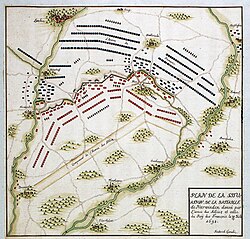Battle of Neerwinden (1693)
| Battle of Landen | |||||||
|---|---|---|---|---|---|---|---|
| Part of the Nine Years' War | |||||||
 Map of the battle. The Allied armies are in red |
|||||||
|
|||||||
| Belligerents | |||||||
|
|
|
||||||
| Commanders and leaders | |||||||
| Marshal Luxembourg | William III of England and II of Scotland | ||||||
| Strength | |||||||
| 80,000 | 50,000 | ||||||
| Casualties and losses | |||||||
| 9,000 | 19,000 | ||||||
The Battle of Landen (or Neerwinden), in the current Belgian province of Flemish Brabant, was a battle in the Nine Years' War, fought in present-day Belgium on 29 July 1693 between the French army of Marshal Luxembourg and the Allied army of King William III of England. The French assaulted the Allied position three times before the French cavalry finally penetrated the allied defences and drove William's army from the field in a rout. The battle was, however, quite costly for both sides, the French losing 9,000 men to the Allies' 19,000. The French failed to follow up on their victory, allowing William to escape.
Marshal Luxembourg, having with a series of feints induced William to detach portions of his army, rapidly drew together superior numbers in the face of the Allied camps, which lay in a rough semicircle from Eliksem on the right to Neerlanden, thence along the Landen brook on the left (18–28 July 1693). William had no mind to retire over the Gete River and entrenched a strong line from Laar through Neerwinden to Neerlanden.
On the right of this line (Laar to Neerwinden), the ground was broken and gave plenty of cover to both sides; this section, being regarded as the key to the position, was strongly garrisoned. In the centre the open ground between Neerwinden and Neerlanden was solidly entrenched; in front of it Rumsdorp was held as an advance post. The left at Neerlanden rested upon the Landen brook and was difficult to access.
William's right (his line of retreat lay over the Gete) was his dangerous flank, and Marshal Luxembourg was aware that the Allies' front was somewhat long for the numbers defending it. The intervention of troops drawn from one wing to reinforce the other would almost certainly be too late. Under these conditions Luxembourg's general plan was to throw the weight of his attack on the Laar-Neerwinden section—especially on Neerwinden itself—and to economize his forces, as "economy of force" was understood before Napoleon's time. Elsewhere, delivering holding attacks or demonstrations, as might be necessary, would thus prevent the Allied centre and left from assisting the right.
...
Wikipedia
